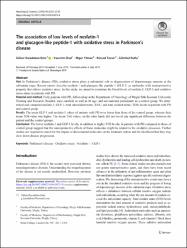The association of low levels of nesfatin-1 and glucagon-like peptide-1 with oxidative stress in Parkinson's disease
Özet
AimIn Parkinson's disease (PD), oxidative stress plays a substantial role in degeneration of dopaminergic neurons at the substantia nigra. Recent reports describe nesfatin-1 and glucagon-like peptide-1 (GLP-1) as molecules with neuroprotective property that relieve oxidative stress. In this study, we aimed to determine the blood levels of nesfatin-1, GLP-1 and oxidative stress status in patients with PD.Material and methodForty patients with PD, followed-up at the Department of Neurology of Mugla Sitki Kocman University Training and Research Hospital, were enrolled, as well as 40 age- and sex-matched participants as a control group. We determined and compared nesfatin-1, GLP-1, total antioxidant status (TAS), and total oxidant status (TOS) levels in patients with PD and control group.ResultsThe mean GLP-1 and nesfatin-1 values of patients with PD were lower than those of the control group, whereas their mean TOS value was higher. The mean TAS values, on the other hand, did not reveal any significant difference between the patient and the control groups.ConclusionThe lower nesfatin-1 and GLP-1 levels, in addition to higher TOS levels, in patients with PD compared to those of control group suggest that the neuroprotective effects of these molecules might be related to the oxidative processes. Further studies are required to search for the impact of abovenamed molecules on the treatment option and the likelihood that they may slow down disease progression.


















